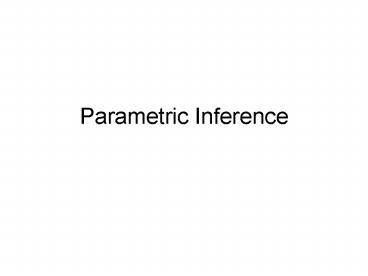Parametric Inference - PowerPoint PPT Presentation
1 / 20
Title:
Parametric Inference
Description:
Asymptotic convergence of sample to true distance for at least one ... Fact (Cramer Rao bound): Lower bound on the variance of any unbiased estimator of ? ... – PowerPoint PPT presentation
Number of Views:89
Avg rating:3.0/5.0
Title: Parametric Inference
1
Parametric Inference
2
Properties of MLE
- Consistency
- True parameter
- MLE using n samples
- Define
- Condition 1
- Condition 2
Asymptotic convergence of sample to true distance
for at least one parameter value
Model is identifiable
3
Properties of MLE
- Equivariance
- Condition g is invertible (see proof)
- - g is one-to-one and onto
4
Properties of MLE
- Asymptotic normality
True standard error
Approximate standard error
Fisher information at true parameter value ?
Fisher information at MLE parameter value
5
Fisher information
- Define score function
Rate of change of log likelihood of X w.r.t.
parameter ?
Fisher information at ?
Measure of information carried by n IID data
points X1, X2, Xn about the model parameter ?
Fact (Cramer Rao bound)
Lower bound on the variance of any unbiased
estimator of ?
6
Parametric Bootstrap
- If t is any statistic of X1, X2, ., Xn
Nonparametric bootstrap Each tb is computed
using a sample Xb,1, Xb,2, ., Xb,n
(empirical distribution) Parametric bootstrap
Each tb is computed using a sample Xb,1, Xb,2,
., Xb,n (MLE or Method of
moments parametric distribution)
7
Sufficient statistic
- Any function of the data Xn T(X1, X2, ., Xn) is
a statistic - Definition 1
- T is sufficient for ?
Likelihood functions for data sets xn and yn have
the same shape
Recall that likelihood function is specific to an
observed data set xn !
8
Sufficient statistic
- Intuitively T is the connecting link between data
and likelihood - Sufficient statistic is not unique
- For example, xn and T(xn) are both sufficient
statistics
9
Sufficient statistic
- Definition 2
- T is sufficient for ?
- Factorization theorem
- T is sufficient for ? if and only if
Distribution of xn is conditionally independent
of ? of given T
Implies the first definition of sufficient
statistic
10
Sufficient statistic
- Minimal sufficient
- a sufficient statistic
- function of every other sufficient statistic
- T is minimal sufficient if
- Recall T is sufficient if
11
Sufficient statistic
- Rao-Blackwell theorem
- An estimator of ? should depend only on the
sufficient statistic T, otherwise it can be
improved. - Exponential family of distributions
one parameter ?
multiple parameters
12
Sufficient statistic
- Exponential family
- n IID random variables X1, X2, ., Xn have
distribution - Examples include Normal, Binomial, Poisson.
Also exponential
is a sufficient statistic (Factorization theorem)
13
Iterative MLE
- Start with an initial guess for parameter(s).
Obtain improved estimates in subsequent
iterations until convergence. - Initial parameter value could come from the
method of moments estimator. - Newton-Raphson
- Iterative technique to find a local root of a
function. - MLE is equivalent to finding the root of the
derivative of log likelihood function.
14
Newton-Raphson
- Taylor series expansion of around current
parameter estimate
For MLE,
Solving for ,
Multi-parameter case
where
15
Newton-Raphson
Slope
Slope
MLE
MLE
16
Expectation Maximization
- Iterative MLE technique used in missing data
problems. - Sometimes introducing missing data simplifies
maximizing of log likelihood. - Two log likelihoods (complete data and incomplete
data) - Two main steps
- Compute expectation of complete data log
likelihood using current parameters. - Maximize the above over parameter space to obtain
new parameters.
17
Expectation Maximization
Incomplete
Data
Log likelihood
Complete
Data
Log likelihood
Expected log likelihood
18
Expectation Maximization
- Algorithm
Start with an initial guess of parameter
value(s). Repeat steps 1 and 2 below for j 0,
1, 2, .
1. Expectation Compute
2. Maximization Update parameters by maximizing
the above expectation over parameter space
19
Expectation Maximization
- Fact
OR
Incomplete data log likelihood increases every
iteration! MLE can be reached after a sufficient
number of iterations
20
Thank you!































